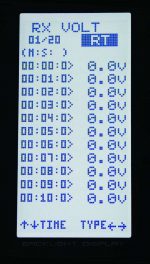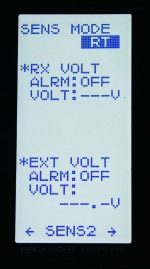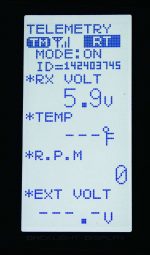This article was originally published in RC Driver’s August 2015 issue.
By Mark Ronge
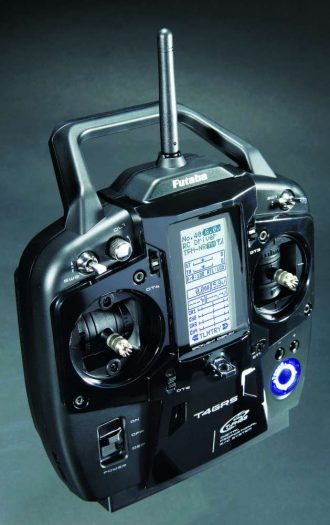
While most of us in the RC surface world are used to pistol grip transmitters, twin stick transmitters will always have their place in the hobby. Already popular in the RC boating segment, twin sticks are indispensable in both high end rock crawling and scale applications. While not just reserved for these segments, the brand new Futaba 4GRS radio is perfect for cars and boats alike. And yes, they can be used for “regular” cars, too. The 4GRS has all sorts of unique features of interest, from available telemetry to highly custom- izable stick settings all at a price lower than most high range four- channel radios. And if you already have any Futaba 2.4GHz receivers you are in the luck, the 4GRS sup- ports Futaba HSS, S-FHSS and T-FHSS technology.
THE GOODS
The Futaba 4GRS is set up in your typical twin stick fashion, with the throttle control on the left and the steering handled by the right stick. The throttle stick can be set up in various ways. One feature I really like is the ability to easily set the neutral position of the stick lower, so that there is much more throttle travel than brake travel. All I had to do to make this change was to flip a switch near the throttle switch and navigate through the menus to let the radio know I am using this feature (more on navigating later). For boaters an optional ratchet plate is available which allows the option to remove the spring in the throttle stick and then the control behaves similar to aircraft. The radio can then be programmed to have the bottom of the travel at zero throttle with no reverse or braking.
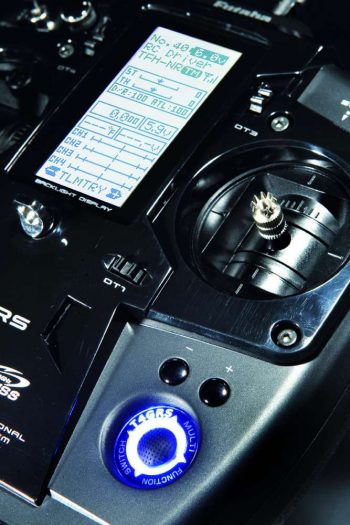
Versatility in one radio is tough to find nowadays and minor adjust- ments are easily made on this one without taking the radio apart, but for those looking to further tweak their radio more options are available. The range of the throttle stick can be adjusted just by turning the screws at the extremities of the travel as a sort of mechanical end point. This is helpful for even more fine tuning of the throttle versus braking percentage. I personally like as much throttle travel as possible, and generally with other radios I have to open it up to make this type of change. If you do want to open up the radio you can change the spring tension on both sticks, but with radios in the price range I always find the default setting perfect. Possibly the most unique feature on this radio is the ability to rotate or tilt the sticks to an angle that more comfortably fits the user’s hands (another modification you can do without disassembling the transmit- ter). Adding to the theme of versatility, the battery tray is very large and can fit all sorts of battery packs. Stock it comes with a 4X standard “AA” holder, but the transmit- ter can use optional NiMH and LiFe packs.
The LCD display is nearly identical to one of Futaba’s newer four-channel radios, the Futaba 4PLS. It is a very bright, backlit display that is very visible in multiple light- ing conditions. In the menus you can even change the contrast setting, something not found on all transmitters. The display is located right in the middle of the radio and makes it very easy to glance down and browse all of the information the 4GRS can transmit. There are plenty of modes to cycle through on what information is shown to the user. The default mode shows a digital representation of what each channel’s inputs are along with digital trim indica- tions and basic telemetry and receiver volt- age. As you use the main toggle to cycle through you will see displays more dedicat- ed to specific functions. I really like the telemetry display; it is so easy to quickly read what is going on with your model. Other modes include more specific voltage readings and a log mode which shows usage time and alarm status.
As far as the everyday transmitter options, the 4GRS radio has a 40 model memory, with up to 10 characters for each name. Our transmitter came with a Futaba R304SB, a 2.4GHz T-FHSS receiver. This receiver is capable of enhanced frame rates when used with digital servos and is com- patible with the telemetry options Futaba sells separately. However, it is capable of transmitting the receiver’s input voltage to the transmitter without the use of any extra add-ons. With the 4GRS, you can directly plug certain Futaba ESCs right into the radio and make complex changes that you would not be able to do by using the con- ventional beep or LED programming meth- od. This is really cool, it lets you change voltage cutoffs for LiPos, timers soft-cutoffs (perfect so your boats don’t get stranded with a dead battery), braking profiles, and all sorts of other options. As for switches, there is one dial, two switches (one of which is a three-position and the other a two-position). Each of these switches are fully programmable to use plenty of the 4GRS functions for each individual model.
But what great four channel radio would be complete without tons of options specifically geared towards the models it is being used with? The 4GRS shines in this department; it has useful modes for any type of surface based vehicle. Many crawl- ers need four-channel radios to handle the various steering mechanisms and often have multiple ESC’s. 4WS gets its own sub- menu within the options and has selections for various conditions and the ability to assign these settings to different toggles and switches. Front axle only steering is as easy as flipping a switch that you indicate in these menus. For cars that use Futaba gyro systems, the rate can be directly con- trolled via the radio. Some 1/5-scale gassers have front and rear brakes on separate channels, and the 4GRS accommodates this with a slew of options, including braking delay and ABS.
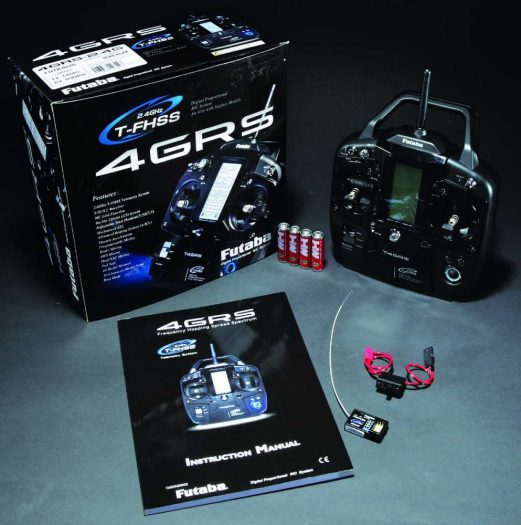
• Transmitter supports all FHSS, S-FHSS and T-FHSS Futaba 2.4GHz receivers for extra versatility
• Four-wheel steering and dual ESC mixing for MOA crawlers and various scale projects
• 40 model memory
• Large, backlit LCD screen with adjustable contrast options
• Rx voltage automatically displayed using included R304SB 2.4GHz 4-Channel T-FHSS Receiver
• External voltage, temperature and rpm telemetry available with optional sensors
• Multiple ways to set up switches and dials including front and rear independent brake mixing
• Data transfer for PC use and firmware updates
• Stick tilt
THE WORKS
When testing out new transmitters, I always take note of the binding process and wheth- er or not I will have to bust the manual out in the future every time I buy a new receiv- er. The Futaba is super simple to bind new receivers to, the only thing you have to remember is to put the radio into display mode first, and then the rest of the steps are very intuitive. Like other high end radio/ receiver combos, there is the ability to set the transmitter into high speed mode for increased servo frame rate. When setting up your new receiver the options are very clear as to which mode you are in before you bind and the process is even easier. Just put the transmitter in bind mode, and you have 20 seconds to press the corresponding link button on the receiver. That’s all there was to it, no muss no fuss.
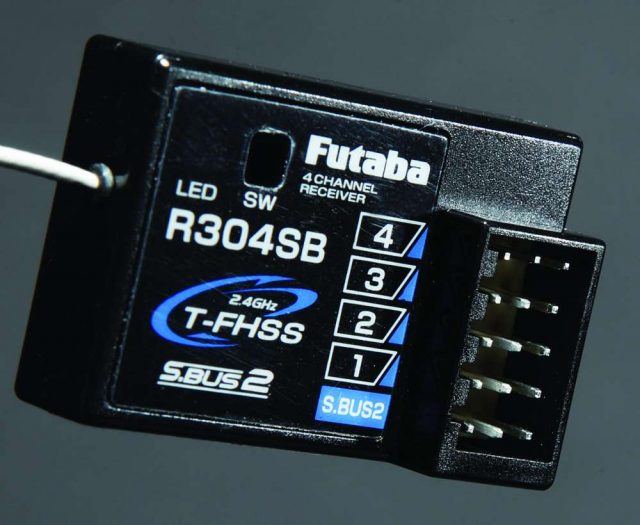
Now it was time to get a feel for the transmitter. With four “AA” batteries installed the radio is pleasantly light, some- thing very comfortable for extended usage but not so light that it feels cheap. The sticks move very smoothly, and as men- tioned before the stick tension can be modi- fied. I immediately put the throttle stick in the 70% acceleration and 30% braking mode, I definitely prefer the longer stroke for throttle control versus braking since I am mainly using this on crawlers and boats in which braking is not as important. I am used to aircraft transmitters so I did not feel the need to tilt the sticks, but the feature is really cool nonetheless. The switches are easy to access and I really like that one of the switches is a dial, which could be very useful for a number of things, including an idle-up mode, or even subtrim for those models that tend to take a lot of hits.
Navigating the menu was a breeze, just hitting any direction on the jog switch brings up all the options the radio has to offer, each of which is almost self-explanatory. This isn’t to say there is any guesswork, Futaba makes some of the most complete and easy to read manuals on the market, this thing is huge! The screen is bright and vibrant and stands out in bright weather outside as well as at dark indoor tracks. I really like having the option of different display screens. I messed around with the lap timer function and it actually has a lot of depth to it. It can store up to 100 laps in the memory and since this radio has easier-to-access switches than traditional wheel-type radios you can trigger the switch without having your thumbs leave the throttle and steering. You can spend all day going through the menus find- ing all the cool features, but the main point is this radio is chock full of them and if you want a radio to do something, chances are this radio can.
Lastly, from a functional standpoint, the 4GRS did not miss a beat in my testing. I installed the Futaba R304SB receiver in a crawler I had laying around and ran the usual tests. Range was not an issue, I could drive the crawler further then I could see, so I have no doubt that when I use this radio for my fast boats the signal will be strong. I was able to take advantage of the quicker refresh rate since my model had digital servos and was rewarded with a seemingly more precise movement and speed. Setup of the four-wheel steering was easier than other radios I have tested due to the visual representations of all the modes the radio will cycle through. I set up my switch so I could cycle through every steer- ing combination possible because, why not? At the end of my testing session I totally forgot I was using a twin stick radio and because I could better sense where neutral was in reference to the travel of the steering I felt like I had more control.
WRAP-UP
The Futaba 4GRS provides incredible value by offering nearly all the functional- ity of much more expensive radio at half of the price. Everything was super simple to set up and within about an hour I felt like I knew the whole system inside and out. I was able to set up multiple four- wheel steering profiles in no time, which means more time out driving and less time with the boring stuff. The Futaba 2.4GHz technology never missed a beat and by the end of the day I absolutely loved this radio. I may be one of the only guys out crawling with a twin stick radio around me, but when they try the 4GRS I know they will be believers!
Link
Futaba futaba-rc.com (217)-398-8970
 RC Driver The Best In RC Car & Truck News, Reviews & Video
RC Driver The Best In RC Car & Truck News, Reviews & Video 


